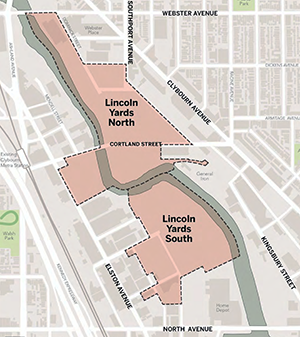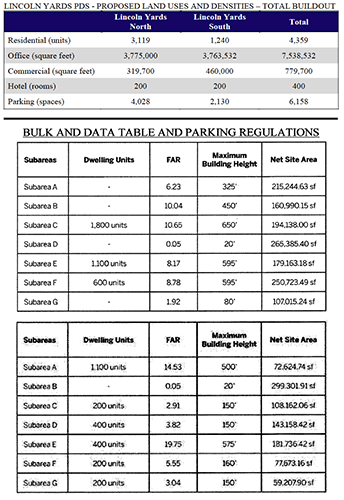Updated on 31 January 2019
The city of Chicago has released a massive report on traffic around the proposed Lincoln Yards development, details of which differ from those previously released.
At a Jan. 24 hearing of the Chicago Plan Commission on Lincoln Yards, city officials released a document that addresses a major concern of area residents: traffic congestion caused by motor vehicles in and out of Lincoln Yards.
Lincoln Yards' 54 acres would straddle the Chicago River's North Branch, north and south of Cortland St.
Last November, the city revealed its plan to use public funds to build "major infrastructure improvements"—such as streets, bridges, water pipes, sewers, and transit—that it said "are needed to transition the area to a modern, mixed-use business corridor."
At several public meetings that the city has held concerning Lincoln Yards, area residents and activists have questioned how the city forecasted the street infrastructure the complex would require.
Residents have repeatedly expressed concern that neighboring areas—such as Bucktown and Lincoln Park—would be swamped by traffic in and out of Lincoln Yards. The site's developer, Sterling Bay, has said that Lincoln Yards would comprise up to 6,000 residential units and 24,000 permanent workers, with a "minimum 50 percent" of the area used for commercial space.
During the Jan. 24 Plan Commission hearing, Chicago Dept. of Transportation (CDOT) Commissioner Rebekah Scheinfeld described a traffic study commissioned by Sterling Bay.

Source: city of Chicago.
The study, according to its text, aimed to "assess the impact" of Lincoln Yards on local traffic, "and determine the transportation improvements that will be necessary to accommodate traffic generated by" Lincoln Yards.
Scheinfeld said that the study showed that the city's plans for street, bridge, and intersection improvements would provide "sufficient capacity" for motor vehicle traffic spawned by Lincoln Yards.
When asked by a reporter during the hearing about the study's availability, Scheinfeld said that CDOT could make it available.
Later on, Ald. Brian Hopkins, in comments to the Plan Commission, said that the traffic study could be found on his Web site, aldermanhopkins.com. Lincoln Yards would reside entirely within Hopkins' 2nd Ward.
The 740-page study was done for Sterling Bay by traffic consulting firm Kenig, Lindgren, O’Hara, Aboona, (KLOA) Inc.
In a summary of the KLOA study e-mailed to reporters, CDOT said that "enhanced capacity provided by new bridges at Armitage, Dominick and Concord will exceed demand by about 10 percent." In his Plan Commission remarks, though, Hopkins put that figure at 15 percent—citing the traffic study.

A table from KLOA's Lincoln Yards traffic study (top) assumes a total of
4,359 residential units, while material presented to the Chicago Plan
Commission ("Bulk and Data Table") shows a total of 6,000 units.
Source: city of Chicago, Ald. Brian Hopkins.
Hopkins touted the study as a rebuttal to community members' concerns about the traffic volume caused by the development. In fact, Hopkins declared, thanks to planned road improvements, "Lincoln Yards could relieve congestion rather than cause it."
But questions remain about the traffic study's validity.
One uncertainty: the total number of residential units in Lincoln Yards that could generate traffic.
In Sterling Bay's most recent "master plan," posted on Jan. 19 to its lincolnyards.com Web site and excerpted for the Jan. 24 Plan Commission hearing, the development will contain 6,000 residential units in two sections: 3,500 units in Lincoln Yards North (roughly north of Cortland St.) and 2,500 in Lincoln Yards South (south of Cortland St.).
KLOA's traffic study, however, identifies 3,119 residential units in Lincoln Yards North and 1,240 in Lincoln Yards South—for a total of 4,359 units.
In other words, Sterling Bay's master plan calls for 38 percent more units than identified in KLOA's traffic study. When asked, CDOT did not explain why.
According to a CDOT spokesperson, the traffic study "was based on the updated plan that was released on January 19" by Sterling Bay.
The Plan Commission voted unanimously (with one abstention) to approve Sterling Bay's applications for planned developments at Lincoln Yards North and South.






